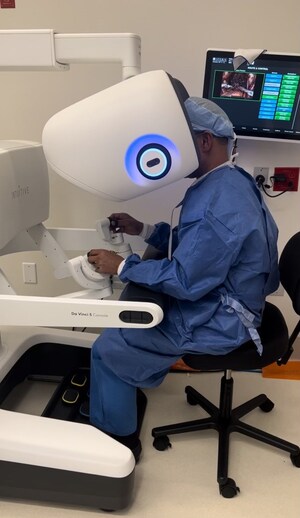Researchers from Hackensack Meridian University Medical Center and Colleagues Develop New Model to Help Clinicians Predict Risk of Death in Patients Hospitalized with COVID-19
New COVID-19 40-day mortality risk model, published in The Public Library of Science ONE, has potential for use in patient treatment planning, comparisons of therapeutic strategies, and public-health preparations
HACKENSACK, N.J., Aug. 5, 2021 /PRNewswire/ -- Researchers from Hackensack Meridian University Medical Center and Berry Consultants, LLC, Austin, Texas have developed a new model to help clinicians predict the risk of death within 40 days in patients who are hospitalized with COVID-19 infection.
A new paper describing this retrospective, observational, multicenter cohort analysis, "Development and validation of a prognostic 40-day mortality risk model among hospitalized patients with COVID-19," was recently published in PLOS ONE, a peer-reviewed, open-access scientific journal.
The model considers six risk factors: age, respiratory and oxygenation rates, and preexisting conditions such as high blood pressure, coronary artery disease, or chronic kidney disease that play a role in COVID-19 deaths. Older age was determined to be the strongest predictor of death, according to health records of patients who were hospitalized with COVID-19 in a large New Jersey health network between March 1, 2020 and April 22, 2020.
"The death of every person who has passed from COVID-19 has been an enormous human tragedy, and we are working to prevent future mortality from the pandemic through vaccination, optimal care and research for new therapeutics," said Ihor S. Sawczuk, MD, FACS, regional president, Chief Research Officer, Hackensack Meridian Health northern market. "This new analysis to predict mortality in certain patients with COVID-19 was done to better understand who is most at risk for this outcome in order to do everything possible to save the lives of people who are most vulnerable to complications from this viral infection."
"It's significant that severe COVID-19 disease has occurred principally among individuals with pre-existing comorbid conditions, said Andrew Ip, MD, Division of Outcomes and Value Research, John Theurer Cancer Center at Hackensack University Medical Center, Hackensack NJ.
"Well-validated mortality models incorporating comorbidities and presenting features, similar to models used to prognosticate survival of patients in intensive care units have been lacking for COVID-19," added Dr. Stuart Goldberg, Associate Professor of Medicine at Hackensack Meridian School of Medicine.
"Age is by far the most important risk factor in our study, with mortality risk increasing with the cube of age," said Donald A. Berry, PhD, a statistician with Berry Consultants. He added, "Whether this relationship is maintained for the now dominant delta variant of coronavirus SARS-CoV-2 remains to be seen."
A report from the US Centers for Disease Control and Prevention noted that 38% of COVID-19 patients had one or more underlying conditions. Patients with comorbidities are more likely to require hospitalization and intensive care support compared to individuals without additional risk factors. Moreover, high case fatality rates have been reported particularly among the elderly and people who reside in nursing homes.
The researchers developed and validated a prognostic mortality model that incorporated both pre-existing comorbidities and presenting features among people hospitalized with COVID-19 illness. Through April 22, 2020 Hackensack Meridian Healthcare's network of 13 hospitals within New Jersey had provided care to more than 3,000 COVID-19 patients and had experienced over 700 deaths. Using this cohort, the researchers presented a new model that quantifies risk of mortality within 40 days of hospitalization for COVID-19 illness.
Study Methods
The authors retrospectively reviewed the electronic health records of hospitalized patients within a 13-hospital New Jersey network between March 1, 2020 and April 22, 2020 with positive polymerase chain reaction results for SARS-CoV-2, the virus responsible for COVID-19 illness, with follow-up through May 29, 2020. With death or hospital discharge by day 40 as the primary endpoint, they used univariate followed by stepwise multivariate proportional hazard models to develop a risk score on one-half the data set, validated on the remainder, and converted the risk score into a patient-level predictive probability of 40-day mortality.
Study Results
The study population consisted of 3123 hospitalized COVID-19 patients; median age 63 years; 60% were men; 42% had >3 coexisting conditions. 713 (23%) patients died within 40 days of hospitalization for COVID-19. From 22 potential candidates, 6 factors were found to be independent predictors of mortality and were included in the risk score: age, respiratory rate ≥25/minute upon hospital presentation, oxygenation <94% on hospital presentation, and pre-hospital comorbidities of hypertension, coronary artery disease, or chronic renal disease. The risk score was highly prognostic of mortality in a training set and confirmatory set yielding in the combined dataset a hazard ratio of 1.80 (95% Confidence Interval 1.72, 1.87) for one unit increase in the risk score. An online calculator of this 40-day COVID-19 mortality risk score is available at www.HackensackMeridianHealth.org/CovidRS
Predicting Risk of Death for COVID-19 Patients
Risk factors were considered in developing the mortality risk score model, with 17 factors passing step one by demonstrating a statistically significant level. These factors were entered into the risk model, and after eliminating the least significant factors, 6 factors remained in the mortality risk model: age, respiratory rate ≥25/minute upon hospital presentation, oxygenation <94% on hospital presentation, and pre-hospital comorbidities of hypertension, coronary artery disease, or chronic renal disease.
"The ability to predict death or survival of patients with severe COVID-19 infection, upon entry to the hospital, based on pre-existing comorbidities and presenting features, would permit healthcare teams to strategize individual treatment planning, more accurately evaluate the efficacy of new therapies, and assist in public-health resource allocations," said Brett E. Lewis, MD, a study author who is a radiation oncologist at the John Theurer Cancer Center at Hackensack University Medical Center, Hackensack NJ .
ABOUT HACKENSACK UNIVERSITY MEDICAL CENTER
Hackensack University Medical Center, a 771-bed nonprofit teaching and research hospital located in Bergen County, is the largest provider of inpatient and outpatient services in New Jersey. Founded in 1888 as the county's first hospital, it was the first hospital in New Jersey and second in the nation to become a Magnet®-recognized hospital for nursing excellence. The academic flagship of Hackensack Meridian Health, Hackensack University Medical Center's campus is home to facilities such as John Theurer Cancer Center, the #1 hospital for cancer care in New Jersey in U.S. News & World Report's 2020-21 "Best Hospitals" Honor Roll; the Heart & Vascular Hospital; and the Sarkis and Siran Gabrellian Women's and Children's Pavilion, which houses the Joseph M. Sanzari Children's Hospital and Donna A. Sanzari Women's Hospital. Recognized as being in the top 1% of hospitals in the nation and #2 in New Jersey by U.S. News & World Report's 2020-21 "Best Hospitals" Honor Roll, Hackensack University Medical Center also ranked as high-performing in nine specialties: cancer care, cardiology and heart surgery, gastroenterology and GI surgery, geriatrics, nephrology, neurology and neurosurgery, orthopedics, pulmonology, and urology. Hackensack University Medical Center's comprehensive clinical research portfolio includes studies focused on precision medicine, translational medicine, immunotherapy, cell therapy, and vaccine development. The hospital has embarked on the largest healthcare expansion project ever approved by the state: Construction of the Helena Theurer Pavilion, a 530,000-sq.-ft., nine-story building which will house 24 operating rooms with intraoperative MRI capability, 50 ICU beds, and 150 private patient rooms, including a 50-bed Orthopedic Institute.
SOURCE Hackensack University Medical Center

Related Links
WANT YOUR COMPANY'S NEWS FEATURED ON PRNEWSWIRE.COM?
Newsrooms &
Influencers
Digital Media
Outlets
Journalists
Opted In






Share this article